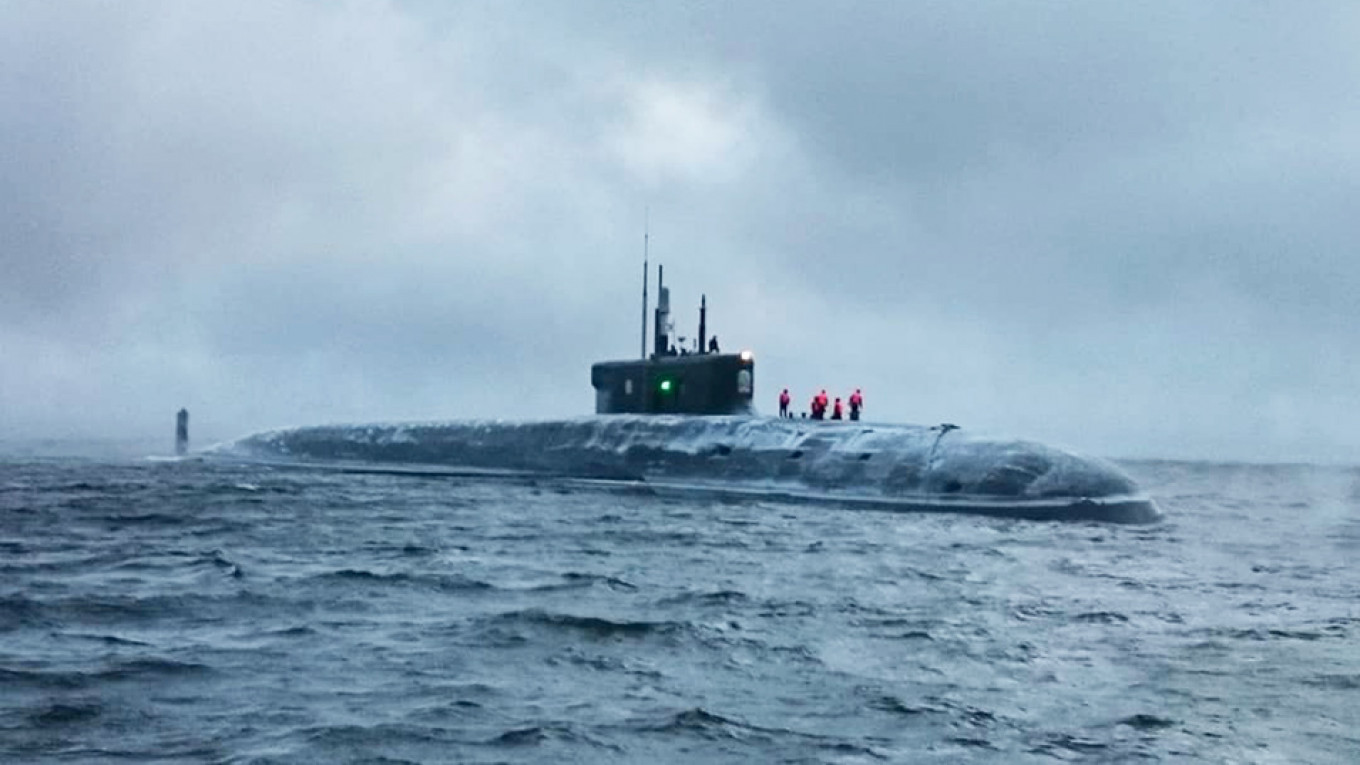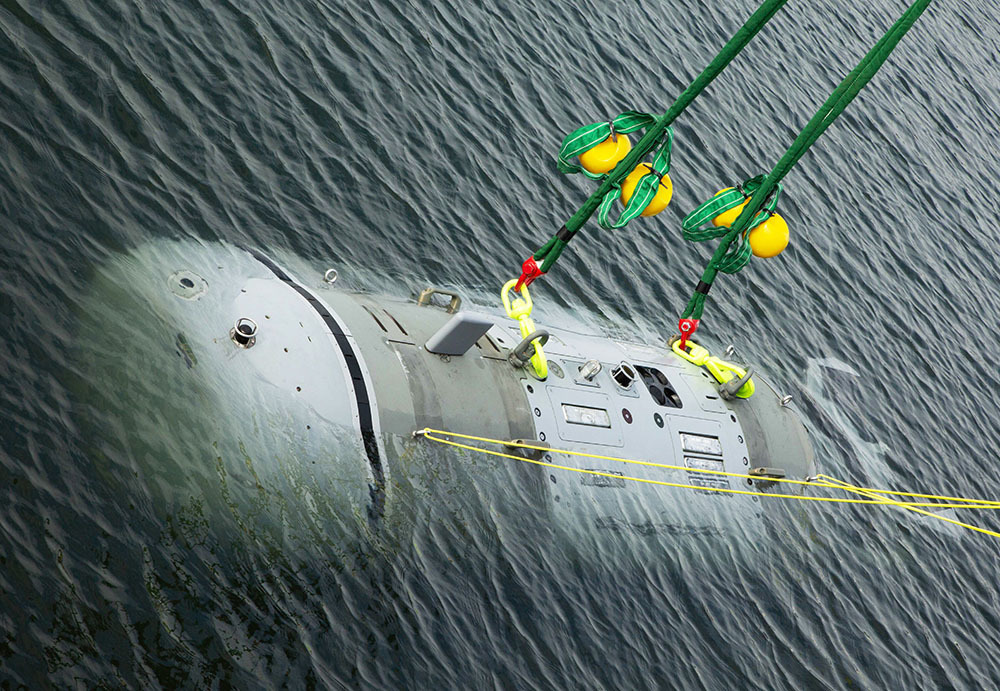At the Army Forum 2022, Russian defense corporations have gone on a spree of unveiling one state-of-the-art system after another. In what could significantly level up Moscow’s maritime power, the Russian ship design bureau Rubin has revealed its latest advanced submarine concept.
America’s Mammoth $13B Missile Program Back In Spotlight As US Tests Its 1960-Era Minuteman-III ICBM
On August 15, Russian President Vladimir Putin said that many samples of Russia’s new generation weapons are years and even decades ahead of their foreign counterparts. Keeping up with this sentiment, Rubin has unveiled a submarine concept that would succeed the latest Borei-class in the Russian arsenal.
Named “Arktur” or Arcturus, after the brightest star in the northern celestial hemisphere, the new ballistic missile submarine (SSBN) is an innovative design. It was seen paired with a large-displacement unmanned underwater vehicle, Surrogat-V, in pictures from Army Forum 2022.
According to the design, the vessel might serve as a mothership for the massive Surrogat-V and a multipurpose platform with adjustable vertical launch tubes for future payloads.

The most noteworthy feature of the vessel design was the angled outer hull, sloping sides, and blended lines. It has a chine that runs the entire side length, like a modern low-observable aircraft, noted naval analyst H.I. Sutton for Naval News.
Future "Arctic" SSBN concept: "Arktur" and its companion UUV "Surrogat-V".
Photos by @MuxelAero.Borei-A for comparison. #ARMY2022 pic.twitter.com/nVcunL7NFG
— Dmitry Stefanovich (@KomissarWhipla) August 15, 2022
Arktur’s design has an angled outer hull to make it super stealthy. The classic passive-sonar stealth would be used with the angled outer hull, which is meant to thwart active sonar. This entails mounting the machinery on rafts to isolate noise sources.
In addition, complex Russian anechoic coatings widely used on their submarines would also be used outside the pressure hull. This coating is a protective fluid film layer usually applied on a metal’s surface to prevent reducing a submarine’s acoustic signature.
It is consistent with similar concepts used in other nations to deflect incoming active sonar, like the Type-212CD, a German design produced for Germany and Norway, and the ballistic missile submarine of the British Dreadnought class.
The British Dreadnought claims to be the stealthiest submarine yet. The sub is slightly larger, mainly to incorporate several new stealth features.
The official graphics used by the builder, BAE Systems, showed the chine running along the hull much like the Arcturus. Dreadnought will also be coated with anechoic tiles.

Moscow’s Arcturus will succeed the Borei-class submarines, replacing the cold-war era Typhoon and Delta-class subs. These vessels are expected to form a core of the Russian nuclear triad until 2040, which might now also include the new stealthier Arcturus.
Next-Gen Submarines For Nuclear Deterrence
The submarine will have twelve missile silos that can accommodate nuclear-tipped ballistic missiles, which seems to be the primary purpose. However, one of the tubes has a launch and retrieval system for a medium-sized Unmanned Underwater Vehicle (UUV), meaning it will play multiple roles.
Compared to the current SSBNs, 12 tubes is a smaller number, but other submarine manufacturers are moving in the same direction, according to a Naval News report. For instance, the Borei-class submarine is armed with sixteen Bulava ballistic missiles.
The number of missiles needed to guarantee unacceptably high losses for an opponent decreases as missiles get more powerful. Additionally, the missiles are costly to manufacture and maintain. The submarine, probably intended to create nuclear deterrence, might operate in the Arctic.
Though "Arktur" is an SSBN in name the design suggests a multirole platform including reconfigurable vertical launch tubes for potentially other payloads and as mothership to large UUV "Surrogat-V" pic.twitter.com/iR43mQtsMl
— Joseph Dempsey (@JosephHDempsey) August 15, 2022
The Arktur appears to have some full shrouded propeller arrangement that allows water to enter through four different ducts on either side of the stern, top, and bottom, and then be propelled out through nozzle portions at the back. Although it is uncertain if the design uses pump jets hidden under the submarine’s tail, as observed in The War Zone.
One of the most significant features of the concept is the Unmanned Underwater Vehicle Surrogat-V.
The Arktur design for a future SSBN is highly intriguing, especially given that it might be able to transport up to two Surrogat-V UUVs.
Even while it’s unclear exactly what those drone submarines’ intended uses could be, it’s simple to see how they can be used as underwater “loyal wingmen” to help defend the incredibly high-value strategic asset they are launched and recovered from.
The UUVs are growing in importance. Last month, the US Navy demonstrated an end-to-end intelligence preparation of the operational environment (IPOE) mission with a prototype of the Snakehead large displacement uncrewed undersea vehicle (LDUUV), as previously reported by EurAsian Times.

The Snakehead, with a cargo capacity greater than small and medium UUVs, is the largest submarine-launched UUV in the US Navy and is nearly the same size as a SEAL delivery vehicle (SDV).
To preserve its dominance in the underwater domain, the US Navy is actively investing in UUV capabilities. This could incentivize Russia to explore a more significant role for its Surrogat-V UUVs.
Navies of several countries, including China, are trying to incorporate UUVs as they try to protect their personnel from risky environments. UUVs can go deeper underwater and stay for longer durations, enabling real-time actionable intelligence without much human intervention.
According to Sutton, Surrogat-V is a drone for anti-submarine warfare. It has a pump jet propeller and a reasonably sizeable conformal sonar array, which indicates fast underwater speeds.
It also has a non-acoustic submarine detecting system called SOKS (System Obnarujenia Kilvaternovo Slide). This “sniffs” the radiation and chemicals a submarine leaves behind to track it.
Even though the design concept is up-and-coming, it does not seem to have been sanctioned by the government because it does not have a project number. However, the future of submarines does seem to have the latest entrant with Russia’s advanced design.
- Contact the author at sakshi.tiwari9555@gmail.com
- Follow EurAsian Times on Google News





